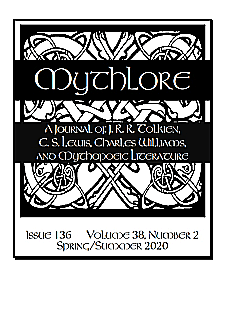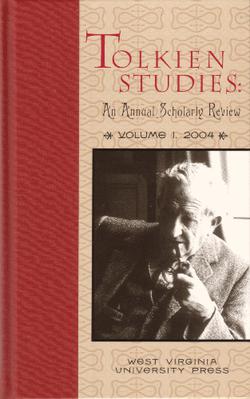
Arwen Undómiel is a fictional character in J. R. R. Tolkien's Middle-earth legendarium. She appears in the novel The Lord of the Rings. Arwen is one of the half-elven who lived during the Third Age; her father was Elrond half-elven, lord of the Elvish sanctuary of Rivendell, while her mother was the Elf Celebrian, daughter of the Elf-queen Galadriel, ruler of Lothlórien. She marries the Man Aragorn, who becomes King of Arnor and Gondor.
In J. R. R. Tolkien's legendarium, Lothlórien or Lórien is the fairest realm of the Elves remaining in Middle-earth during the Third Age. It is ruled by Galadriel and Celeborn from their city of tree-houses at Caras Galadhon. The wood-elves of the realm are known as Galadhrim.

Thomas Alan Shippey is a British medievalist, a retired scholar of Middle and Old English literature as well as of modern fantasy and science fiction. He is considered one of the world's leading academic experts on the works of J. R. R. Tolkien about whom he has written several books and many scholarly papers. His book The Road to Middle-Earth has been called "the single best thing written on Tolkien".

The Mythopoeic Awards for literature and literary studies are given annually for outstanding works in the fields of myth, fantasy, and the scholarly study of these areas. Established by the Mythopoeic Society in 1971, the Mythopoeic Fantasy Award is given for "fiction in the spirit of the Inklings", and the Scholarship Award for non-fiction work. The award is a statuette of a seated lion, with a plaque on the base. It has drawn resemblance to, and is often called, the "Aslan".

The Mythopoeic Society (MythSoc) is a non-profit organization devoted to the study of mythopoeic literature, particularly the works of J. R. R. Tolkien, Charles Williams, and C. S. Lewis. These men were all members of The Inklings, an informal group of writers who met weekly in Lewis' rooms at Magdalen College, Oxford, from the early 1930s until late 1949.
The works of J. R. R. Tolkien have generated a body of research covering many aspects of his fantasy writings. These encompass The Lord of the Rings and The Silmarillion, along with his legendarium that remained unpublished until after his death, and his constructed languages, especially the Elvish languages Quenya and Sindarin. Scholars from different disciplines have examined the linguistic and literary origins of Middle-earth, and have explored many aspects of his writings from Christianity to feminism and race.

Mythlore is a biannual peer-reviewed academic journal founded by Glen GoodKnight and published by the Mythopoeic Society. Although it publishes articles that explore the genres of myth and fantasy in general, special attention is given to the three most prominent members of the Inklings: J. R. R. Tolkien, C. S. Lewis, and Charles Williams. The current editor-in-chief is the Tolkien scholar Janet Brennan Croft. The Tolkien Society describes Mythlore as a "refereed scholarly journal".

Paul Harold Kocher was an American scholar, writer, and professor of English. He wrote extensively on the works of J. R. R. Tolkien as well as on Elizabethan English drama, philosophy, religion, and medicine. His numerous publications include studies of Christopher Marlowe and Francis Bacon. He also authored books on the Franciscan missions of 18th- and 19th-century California.

Tolkien Studies: An Annual Scholarly Review is an academic journal founded in 2004 publishing papers on the works of J. R. R. Tolkien. The journal's founding editors are Douglas A. Anderson, Michael D. C. Drout, and Verlyn Flieger, and the current editors are Michael D. C. Drout, Verlyn Flieger, and David Bratman. It states that it is the first scholarly journal published by an academic press in the area of Tolkien research.
J. R. R. Tolkien's fantasy books on Middle-earth, especially The Lord of the Rings and The Silmarillion, drew on a wide array of influences including language, Christianity, mythology, archaeology, ancient and modern literature, and personal experience. He was inspired primarily by his profession, philology; his work centred on the study of Old English literature, especially Beowulf, and he acknowledged its importance to his writings.

The Road to Middle-Earth: How J. R. R. Tolkien Created a New Mythology is a scholarly study of the Middle-earth works of J. R. R. Tolkien written by Tom Shippey and first published in 1982. The book discusses Tolkien's philology, and then examines in turn the origins of The Hobbit, The Lord of the Rings, The Silmarillion, and his minor works. An appendix discusses Tolkien's many sources. Two further editions extended and updated the work, including a discussion of Peter Jackson's film version of The Lord of the Rings.
Janet Brennan Croft is an American librarian and Tolkien scholar, known for her authored and edited books and journals on J. R. R. Tolkien's Middle-earth fantasy.

A Companion to J. R. R. Tolkien is a 2014 book edited by Stuart D. Lee and published by Wiley-Blackwell. It is a part of the Blackwell Companions to Literature series, which have been described as prestigious reference works, and features authors well-known in the field of Tolkien studies.

The roles of women in The Lord of the Rings have often been assessed as insignificant, or important only in relation to male characters in a story about men for boys. Meanwhile, other commentators have noted the empowerment of the three major women characters, Galadriel, Éowyn, and Arwen, and provided in-depth analysis of their roles within the narrative of The Lord of the Rings.
Jason Fisher is a Tolkien scholar and winner of a Mythopoeic Scholarship Award in 2014 for his book Tolkien and the Study of His Sources: Critical Essays. He served as the editor of the Mythopoeic Society's monthly Mythprint from 2010 to 2013. He is the author of many book chapters, academic articles, and encyclopedia entries on J. R. R. Tolkien.

Tolkien and the Great War: The Threshold of Middle-earth is a 2003 biography by John Garth of the philologist and fantasy author J. R. R. Tolkien's early life, focusing on his formative military experiences during the First World War.

J. R. R. Tolkien was attracted to medieval literature, and made use of it in his writings, both in his poetry, which contained numerous pastiches of medieval verse, and in his Middle-earth novels where he embodied a wide range of medieval concepts.

The Worlds of J. R. R. Tolkien: The Places that Inspired Middle-earth is a 2020 non-fiction book by the journalist and Tolkien scholar John Garth. It describes the places that most likely inspired J. R. R. Tolkien to invent Middle-earth, as portrayed in his fantasy books The Hobbit and The Lord of the Rings. Those places include many that Tolkien lived in or visited in his early life, as well as sites from history and literature. Most are real, for instance with England as the counterpart of the Shire, though some, like Atlantis, are mythical, and others, like Mirkwood, probably have roots in real places. He notes the ambiguities in some of the connections, and that others have made superficial comparisons, such as of Tolkien's towers with various modern towers in Birmingham, where Tolkien lived as a child. Garth presents his theories of the likely origins of some of these places, supporting these with maps and photographs.

J. R. R. Tolkien took part in the First World War, known then as the Great War, and began his fantasy Middle-earth writings at that time. The Fall of Gondolin was the first prose work that he created, and it contains detailed descriptions of battle and streetfighting. He continued the dark tone in much of his legendarium, as seen in The Silmarillion. The Lord of the Rings, too, has been described as a war book.
Bradford Lee Eden is a librarian and musicologist, best known as a Tolkien scholar.














